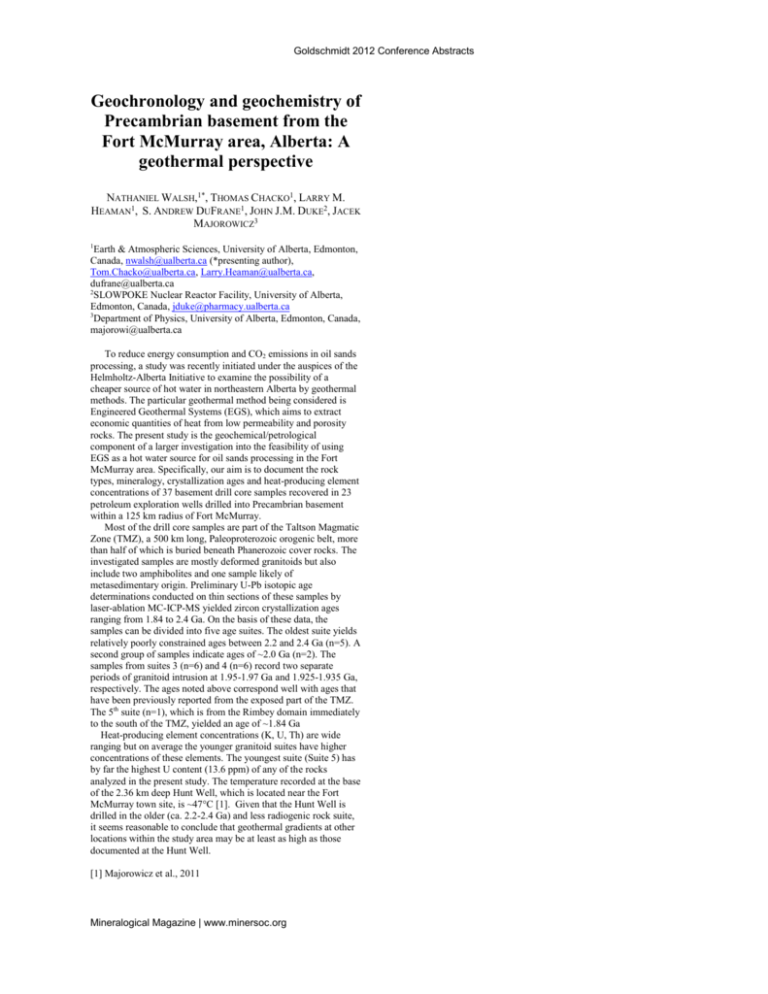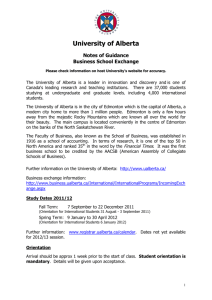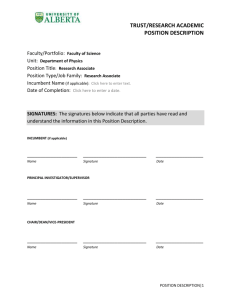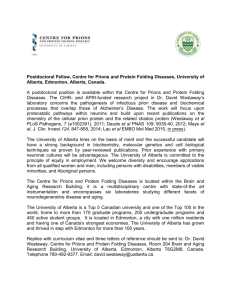Goldschmidt 2012 Conference Abstracts Geochronology and g
advertisement

Goldschmidt 2012 Conference Abstracts Geochronology and geochemistry of Precambrian basement from the Fort McMurray area, Alberta: A geothermal perspective NATHANIEL WALSH,1*, THOMAS CHACKO1, LARRY M. HEAMAN1, S. ANDREW DUFRANE1, JOHN J.M. DUKE2, JACEK MAJOROWICZ3 1 Earth & Atmospheric Sciences, University of Alberta, Edmonton, Canada, nwalsh@ualberta.ca (*presenting author), Tom.Chacko@ualberta.ca, Larry.Heaman@ualberta.ca, dufrane@ualberta.ca 2 SLOWPOKE Nuclear Reactor Facility, University of Alberta, Edmonton, Canada, jduke@pharmacy.ualberta.ca 3 Department of Physics, University of Alberta, Edmonton, Canada, majorowi@ualberta.ca To reduce energy consumption and CO2 emissions in oil sands processing, a study was recently initiated under the auspices of the Helmholtz-Alberta Initiative to examine the possibility of a cheaper source of hot water in northeastern Alberta by geothermal methods. The particular geothermal method being considered is Engineered Geothermal Systems (EGS), which aims to extract economic quantities of heat from low permeability and porosity rocks. The present study is the geochemical/petrological component of a larger investigation into the feasibility of using EGS as a hot water source for oil sands processing in the Fort McMurray area. Specifically, our aim is to document the rock types, mineralogy, crystallization ages and heat-producing element concentrations of 37 basement drill core samples recovered in 23 petroleum exploration wells drilled into Precambrian basement within a 125 km radius of Fort McMurray. Most of the drill core samples are part of the Taltson Magmatic Zone (TMZ), a 500 km long, Paleoproterozoic orogenic belt, more than half of which is buried beneath Phanerozoic cover rocks. The investigated samples are mostly deformed granitoids but also include two amphibolites and one sample likely of metasedimentary origin. Preliminary U-Pb isotopic age determinations conducted on thin sections of these samples by laser-ablation MC-ICP-MS yielded zircon crystallization ages ranging from 1.84 to 2.4 Ga. On the basis of these data, the samples can be divided into five age suites. The oldest suite yields relatively poorly constrained ages between 2.2 and 2.4 Ga (n=5). A second group of samples indicate ages of ~2.0 Ga (n=2). The samples from suites 3 (n=6) and 4 (n=6) record two separate periods of granitoid intrusion at 1.95-1.97 Ga and 1.925-1.935 Ga, respectively. The ages noted above correspond well with ages that have been previously reported from the exposed part of the TMZ. The 5th suite (n=1), which is from the Rimbey domain immediately to the south of the TMZ, yielded an age of ~1.84 Ga Heat-producing element concentrations (K, U, Th) are wide ranging but on average the younger granitoid suites have higher concentrations of these elements. The youngest suite (Suite 5) has by far the highest U content (13.6 ppm) of any of the rocks analyzed in the present study. The temperature recorded at the base of the 2.36 km deep Hunt Well, which is located near the Fort McMurray town site, is ~47°C [1]. Given that the Hunt Well is drilled in the older (ca. 2.2-2.4 Ga) and less radiogenic rock suite, it seems reasonable to conclude that geothermal gradients at other locations within the study area may be at least as high as those documented at the Hunt Well. [1] Majorowicz et al., 2011 Mineralogical Magazine | www.minersoc.org











